
Elizabeth Ruth Grable was an American actress, pin-up girl, dancer, model and singer.

A Yank in the R.A.F. is a 1941 American war drama film directed by Henry King and starring Tyrone Power, Betty Grable and John Sutton. Released three months before the attack on Pearl Harbor plunged the United States into World War II, it is considered a typical early-World War II production. Originally titled The Eagle Squadron, it is based on a story by "Melville Crossman", the pen name for 20th Century Fox studio chief Darryl F. Zanuck. It follows an American pilot who joins the Royal Air Force (RAF), during a period when the United States was still neutral.

Esther Howard was an American stage and film character actress who played a wide range of supporting roles, from man-hungry spinsters to amoral criminals, appearing in 108 films in her 23-year screen career.

Unfaithfully Yours is a 1948 American screwball black comedy film written and directed by Preston Sturges, and starring Rex Harrison, Linda Darnell, Rudy Vallée and Barbara Lawrence. The film is about a jealous symphony conductor who imagines three different ways to deal with the supposed infidelity of his beautiful wife—murder, forbearance, and a suicidal game of Russian roulette—during a concert of three inspiring pieces of classical music. At home, his attempts to bring any of his fantasies to life swiftly devolve into farce, underscored with humorous adaptations of the relevant music. Although the film, which was the first of two Sturges made for Twentieth Century-Fox, received mostly positive reviews, it was not successful at the box office.
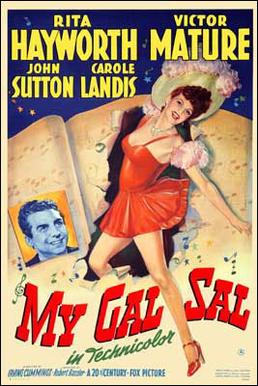
My Gal Sal is a 1942 American musical film distributed by 20th Century Fox and starring Rita Hayworth and Victor Mature. The film is a biopic of 1890s German-American composer / songwriter Paul Dresser and singer Sally Elliot. It was based on a biographical essay, sometimes erroneously referred to as a book, by Dresser's younger brother, novelist Theodore Dreiser. Some of the songs portrayed as Dresser's work were actually written by him, but several others were created in the 1890s style for the film by the Hollywood songwriting team of Ralph Rainger and Leo Robin.

Down Argentine Way is a 1940 American musical film made in Technicolor by Twentieth Century Fox. It made a star of Betty Grable in her first leading role for the studio although she had already appeared in 31 films, and it introduced American audiences to Carmen Miranda. It also starred Don Ameche, The Nicholas Brothers, Charlotte Greenwood, and J. Carrol Naish.

Springtime in the Rockies is an American Technicolor musical comedy film released by Twentieth Century Fox in 1942. It stars Betty Grable, with support from John Payne, Carmen Miranda, Cesar Romero, Charlotte Greenwood, and Edward Everett Horton. Also appearing were Grable's future husband Harry James and his band. The director was Irving Cummings. The screenplay was based on the short story "Second Honeymoon" by Philip Wylie.

Harry Hayden was a Canadian-American actor. He was a highly prolific actor, with more than 280 screen credits.
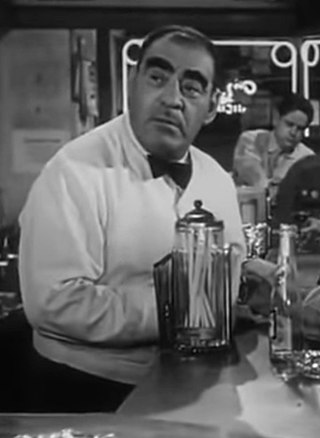
Dewey Robinson was an American film character actor who appeared in more than 250 films made between 1931 and 1952.
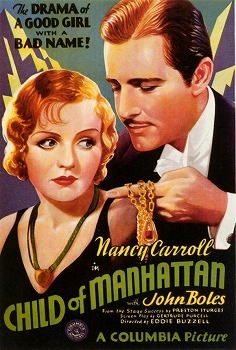
Child of Manhattan is a 1933 American pre-Code melodrama film based on the play Child of Manhattan by Preston Sturges, which was presented on Broadway in 1932. The film was directed by Edward Buzzell and written for the screen by Gertrude Purcell, and stars Nancy Carroll, star of musical comedies at Paramount, John Boles, and cowboy star Charles "Buck" Jones.
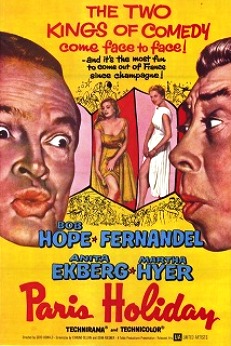
Paris Holiday is a 1958 American comedy film starring Bob Hope, which was directed by Gerd Oswald, and written by Edmund Beloin and Dean Riesner from a story by Hope. The film also features French comedian Fernandel, Anita Ekberg and Martha Hyer, and a rare appearance by writer/director Preston Sturges. The film was shot in Technirama and Technicolor in Paris and in the French village of Gambais.

Georgiana Caine was an American actress who performed both on Broadway and in more than 80 films in her 51-year career.
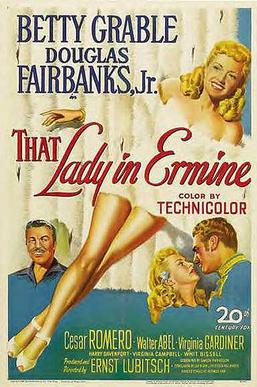
That Lady in Ermine is a 1948 American Technicolor musical film directed by Ernst Lubitsch. The screenplay by Samson Raphaelson is based on the 1919 operetta Die Frau im Hermelin by Rudolph Schanzer and Ernst Welisch.

The Shocking Miss Pilgrim is a 1947 American musical comedy film in Technicolor written and directed by George Seaton and starring Betty Grable and Dick Haymes.

Diamond Horseshoe is a 1945 American musical film starring Betty Grable, Dick Haymes and William Gaxton, directed and co-written by George Seaton, and released by 20th Century Fox. It was filmed in Technicolor in Billy Rose's Diamond Horseshoe, a nightclub located in the basement of the Paramount Hotel. The film's original score is by Harry Warren and Mack Gordon, introducing the pop and jazz standard "The More I See You".
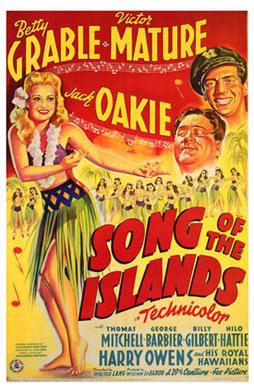
Song of the Islands is a 1942 musical comedy film starring Betty Grable and Victor Mature. It was directed by Walter Lang and released through 20th Century Fox.

Meet Me After the Show is a 1951 Technicolor musical film starring Betty Grable and released through 20th Century Fox. The film was one of Grable's last musical films for Fox during her box office reign of the past decade.
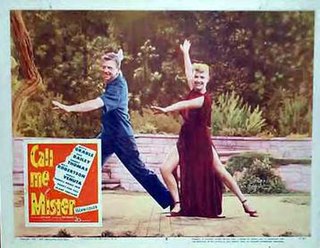
Call Me Mister is a 1951 American Technicolor musical film released by Twentieth Century-Fox. The feature was directed by Lloyd Bacon and re-written from the 1946 Broadway play version by Albert E. Lewin and Burt Styler with music by Harold Rome that featured cast members from the US armed forces.
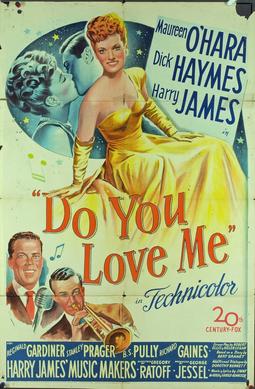
Do You Love Me is a 1946 American Technicolor musical romance film directed by Gregory Ratoff and starring Maureen O'Hara, Dick Haymes and Reginald Gardiner. The film also features band leader Harry James and his Orchestra. It was produced and distributed by 20th Century-Fox. Betty Grable makes a cameo at the end of the film. At the time Harry James was married to contracted Fox star Betty Grable.
Earl Felton (1909–1972) was an American screenwriter.



















